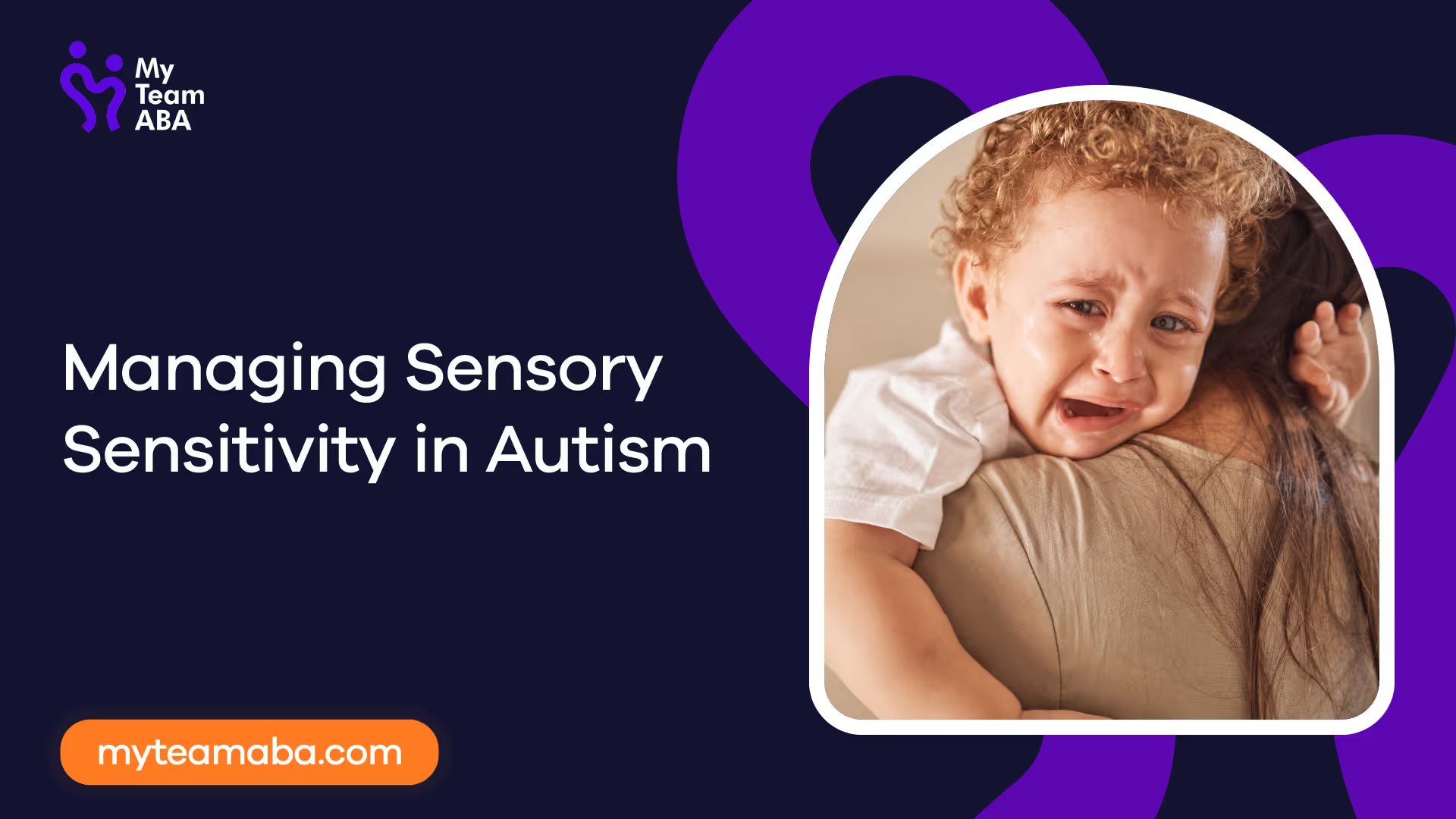Managing Sensory Sensitivity in Autism
March 3, 2025
Unlocking the world of sensory sensitivity in autism. Gain insights, strategies, and support for managing sensory challenges.

Understanding Sensory Sensitivity in Autism
Sensory processing issues are common in individuals with autism spectrum disorder (ASD), affecting 69-95% of individuals on the spectrum. These issues impact how individuals with autism perceive and respond to sensory input from their environment. Understanding sensory sensitivity in autism is crucial for creating supportive environments and implementing effective strategies.
Overview of Sensory Processing Issues in Autism
Sensory processing issues refer to difficulties in how individuals with autism process and respond to sensory information. These issues can affect various sensory modalities, including sight, sound, touch, taste, and smell. The way individuals with autism receive, organize, and respond to sensory input can be different from neurotypical individuals.

For individuals with autism, sensory sensitivities can manifest in different ways. Some individuals may be hypersensitive, meaning they are overly sensitive to certain stimuli. Common triggers for sensory overload in individuals with autism include sounds, lights, textures, and specific environments [1]. Hypersensitivity can lead to discomfort or distress, causing individuals to become overwhelmed and exhibit behaviors like covering their ears, having meltdowns, or avoiding certain environments.
On the other hand, some individuals with autism may experience hyposensitivity, which involves seeking sensory stimulation by actively engaging with it. This can include enjoying loud music, seeking deep pressure, or constantly wanting to touch things. Hyposensitivity can result in difficulties recognizing and responding appropriately to sensory input.
Types of Sensory Sensitivities in Autism
In autism, sensory sensitivities can vary from person to person. Here are some common types of sensory sensitivities observed in individuals with autism:
Type of Sensitivity Description
- Auditory Sensitivity: Hypersensitivity to sounds, such as loud noises, high-pitched sounds, or certain frequencies.
- Visual Sensitivity: Hypersensitivity to bright lights, fluorescent lighting, or specific visual patterns.
- Tactile Sensitivity: Hypersensitivity to certain textures, fabrics, or touch sensations.
- Gustatory Sensitivity: Hypersensitivity to tastes, textures, or temperatures of certain foods.
- Olfactory Sensitivity: Hypersensitivity to smells, including strong or unfamiliar odors.
- Proprioceptive Sensitivity: Hypersensitivity or hyposensitivity to body awareness and movement.
- Vestibular Sensitivity: Hypersensitivity or hyposensitivity to changes in balance, movement, or gravitational input.
Understanding these types of sensory sensitivities is essential for developing effective strategies to support individuals with autism in managing their sensory experiences. By creating sensory-friendly environments and implementing appropriate tools and strategies, individuals with autism can better navigate their sensory sensitivities and thrive in their daily lives.
Hypersensitivity in Autism
Individuals with autism often experience hypersensitivity, a condition in which they are overly sensitive to sensory stimuli. This hypersensitivity can have a significant impact on their daily lives and overall well-being.
Impact of Hypersensitivity on Individuals with Autism
Hypersensitivity in autism can lead to various challenges and difficulties. The overwhelming sensory input from the environment can cause anxiety, stress, or even meltdowns. Individuals with hypersensitivity may become easily overwhelmed by common sounds, lights, textures, or smells, which can interfere with their ability to focus, learn, and engage in everyday activities.
Sensory sensitivities can also impact social interactions and communication. Individuals with hypersensitivity may struggle to engage with others or express themselves effectively due to the distress caused by sensory input. This can lead to feelings of isolation and difficulty in forming and maintaining relationships.
Common Triggers for Sensory Overload
Certain stimuli can trigger sensory overload in individuals with hypersensitivity. These triggers can vary from person to person, but some common examples include:
- Loud Noises: Sudden loud noises, such as sirens, alarms, or crowded environments with multiple conversations, can be overwhelming for individuals with hypersensitivity.
- Bright Lights: Bright or flickering lights, such as fluorescent lighting or strobe lights, can cause discomfort and sensory overload.
- Textures: Some individuals may have aversions to certain textures, such as clothing tags, certain fabrics, or even certain foods.
- Strong Smells: Strong or overpowering smells, such as cleaning products, perfumes, or certain foods, can be overwhelming for individuals with hypersensitivity.
- Tactile Sensations: Certain tactile sensations, such as light touches or unexpected physical contact, can be uncomfortable or distressing for individuals with hypersensitivity.
Understanding these common triggers can help caregivers, educators, and individuals with autism themselves to create sensory-friendly environments and develop effective strategies for managing hypersensitivity. It is crucial to provide support, understanding, and accommodations to help individuals with autism navigate their sensory sensitivities and thrive in their daily lives.
Hyposensitivity in Autism
While hypersensitivity is commonly associated with sensory sensitivity in autism, some individuals may also experience hyposensitivity, which involves a reduced response to sensory stimuli [4]. This means that individuals with hyposensitivity may have a decreased sensitivity to sensory input, such as touch, sound, taste, smell, or sight.
Impact of Hyposensitivity on Individuals with Autism
Hyposensitivity can have various impacts on individuals with autism. Due to the reduced response to sensory input, individuals with hyposensitivity may seek out intense sensory stimulation to compensate for the lack of sensory input they naturally receive [1]. For example, they may enjoy loud music, constantly touch objects, or seek out strong smells.
This seeking behavior can manifest in repetitive actions or rituals that provide the desired sensory input and help regulate their sensory experiences. Engaging in activities like spinning or rocking can provide comfort and help individuals with autism manage their sensory sensitivities.
Seeking Sensory Stimulation in Autism
Individuals with hyposensitivity often seek sensory stimulation actively, as they may not naturally receive enough sensory input. This seeking behavior can serve as a way for them to regulate their sensory experiences and feel more connected to their environment.
It is important for caregivers, educators, and therapists to understand the sensory seeking behaviors associated with hyposensitivity in individuals with autism. By recognizing these behaviors, appropriate strategies can be implemented to provide the necessary sensory input in a safe and controlled manner. This may include incorporating sensory activities, using textured objects, or providing opportunities for movement and exploration.
Supporting individuals with hyposensitivity involves creating an environment that accommodates their sensory needs, ensuring they have access to the sensory stimulation they seek in a controlled and appropriate manner. By understanding and addressing the unique sensory sensitivities experienced by individuals with autism, we can create a more inclusive and understanding environment for their overall well-being.
Managing Sensory Sensitivities in Autism
When it comes to managing sensory sensitivities in individuals with autism, creating a sensory-friendly environment and utilizing sensory tools and strategies can make a significant difference in their daily lives.
Creating a Sensory-Friendly Environment
To support individuals with autism and sensory sensitivities, it is essential to create environments that cater to their specific needs. Here are some strategies for creating a sensory-friendly environment:
- Reduce Sensory Overload: Sensory overload can be overwhelming for individuals with autism. Minimize excessive noise levels by using sound-absorbing materials or providing noise-canceling headphones. Create a calm and quiet space where individuals can retreat when they need a break from sensory stimulation.
- Visual Supports: Visual supports, such as visual schedules and social stories, can provide predictability and reduce anxiety. Use visual cues to help individuals understand and navigate their daily routines, transitions, and expectations.
- Lighting: Be mindful of lighting in the environment. Harsh or flickering lights can be uncomfortable for individuals with sensory sensitivities. Opt for natural lighting or use soft, dimmable lights to create a soothing atmosphere.
- Sensory Zones: Designate specific areas in the environment for different sensory needs. For example, create a quiet corner for relaxation or a sensory-rich area with tactile objects, such as sensory bins or textured materials, for individuals who seek sensory stimulation.
Sensory Tools and Strategies for Regulation
In addition to creating a sensory-friendly environment, providing individuals with autism access to sensory tools and implementing effective strategies can help them regulate their sensory experiences. Here are some examples:
- Fidget Tools: Fidget toys, stress balls, or sensory balls can provide tactile stimulation and help individuals with autism channel their sensory-seeking behaviors in a socially acceptable way. These tools can help promote focus, reduce anxiety, and increase self-regulation.
- Weighted Items: Weighted blankets, vests, or lap pads can provide deep pressure and proprioceptive input, which can have a calming and grounding effect. These items may help individuals with autism feel more secure and relaxed.
- Sensory Breaks: Encourage individuals to take sensory breaks when they feel overwhelmed. This can involve engaging in calming activities, such as deep breathing exercises, listening to calming music, or engaging in preferred sensory activities that provide comfort and relaxation.
- Sensory Diet: Work with professionals, such as occupational therapists, to develop a personalized sensory diet for individuals with autism. A sensory diet consists of specific sensory activities designed to meet their sensory needs and promote self-regulation throughout the day.
By creating a sensory-friendly environment and utilizing sensory tools and strategies, individuals with autism can better manage their sensory sensitivities and navigate their daily lives with greater comfort and ease. It is important to remember that each individual with autism may have unique sensory needs, so it is crucial to tailor supports and accommodations to their specific preferences and sensitivities.
Supporting Individuals with Sensory Sensitivities
When it comes to individuals with sensory sensitivities, particularly those with autism, it is crucial to provide support and understanding to help them navigate their sensory experiences. Caregivers and educators play a vital role in addressing sensory sensitivities and promoting inclusion and understanding.
Caregiver and Educator Role in Addressing Sensory Sensitivities
Caregivers and educators of individuals with sensory sensitivities in autism play a significant role in creating a supportive environment. Here are some key strategies they can implement:
- Education and Awareness: Caregivers and educators should educate themselves about sensory sensitivities in autism. Understanding the challenges individuals face and the impact of sensory overload can help them provide appropriate support. Resources from reputable organizations such as Behavioral Innovations and Autism Speaks can offer valuable insights.
- Individualized Approach: Each individual with sensory sensitivities is unique, and their needs may vary. Caregivers and educators should take an individualized approach, considering the specific sensory challenges and preferences of each person. Open communication with the individual and their families can help tailor support accordingly.
- Accommodations and Modifications: Making necessary accommodations and modifications in the environment can greatly assist individuals with sensory sensitivities. This may include creating quiet spaces, reducing sensory stimuli, providing visual schedules, and using visual supports to aid understanding. Implementing sensory-friendly strategies and tools, such as noise-canceling headphones or weighted blankets, can also be beneficial.
- Sensory Breaks: Offering regular sensory breaks can provide individuals with the opportunity to regulate their sensory input and prevent sensory overload. These breaks can involve engaging in calming activities or utilizing sensory tools, allowing individuals to self-regulate and return to tasks or social situations feeling more comfortable.
Promoting Inclusion and Understanding
In addition to the caregiver and educator's role, promoting inclusion and understanding within the broader community is essential for supporting individuals with sensory sensitivities. Here are some ways to foster a more inclusive environment:
- Education and Awareness: Raising awareness about sensory sensitivities in autism among the community can help foster understanding and acceptance. This can involve sharing information through workshops, seminars, or online resources. Encouraging open conversations and dispelling misconceptions can create a more supportive community.
- Creating Inclusive Spaces: Public spaces, such as schools, workplaces, and recreational facilities, should strive to be sensory-friendly and inclusive. This can be achieved by implementing sensory-friendly design principles, considering lighting, noise levels, and providing sensory accommodations, such as quiet areas or sensory-friendly events.
- Training and Support: Providing training and support to professionals who interact with individuals with sensory sensitivities can enhance their understanding and ability to provide appropriate support. This can include training teachers, healthcare professionals, and community members to recognize and respond effectively to sensory sensitivities.
- Promoting Acceptance: Encouraging acceptance and empathy within the community can have a positive impact on individuals with sensory sensitivities. By fostering a culture of understanding, acceptance, and support, the community can create an environment where individuals with sensory sensitivities feel valued and included.
By acknowledging the caregiver and educator's role in addressing sensory sensitivities and promoting inclusion and understanding, individuals with sensory sensitivities can thrive in a supportive and accepting environment. The collective effort of caregivers, educators, and the community at large can make a significant difference in the lives of individuals with sensory sensitivities in autism.
